Sri Lanka in hunt for its ‘Rikishi’
A contact sport, considered as modern martial arts in its originative country Japan, Sumo has now hit the Sri Lankan shores with as many as 250 athletes engaging in it. Last week a contingent of nine who represented Sri Lanka returned from Osaka, Japan after the World Championship held during the first week of September.
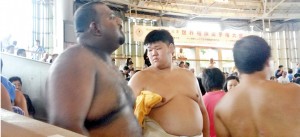
Sri Lanka’s Chamila Karawita moments before his fight in middleweight class
Sri Lankan sumo wrestlers consisting of four male and two female athletes and three officials consider that this year has been their best so far, since its introduction to Sri Lanka in 2011. Kithsiri de Zoysa, the founder President of Sri Lanka Sumo Federation, during the past four years has done his utmost and is still striving to make this century old traditional Japanese sport popular in Sri Lanka.
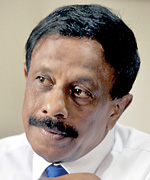
Kithsiri de Zoysa
“The outcome of the recently concluded Sumo World Championship held in Japan is really encouraging. Though sumo was only seen on television, during the past four years it has developed gradually. At the beginning we had just one club and by now the number has reached closer to 15. That itself is a triumph. But the real achievement is the current rankings of three of our wrestlers, Lasantha Gunawardena, Chamila Karawita and Dinesh Jayasinghe. Others too did well, especially the only girl in the team, Dulakshi Kulanayake. She finished among the top 20,” de Zoysa explained.
The Sri Lanka Sumo Federation, a sport association yet to be recognised by the Ministry of Sports, is based at the YMCA Building at Bristol Street in Colombo Fort. The wrestlers make use of the available facilities at YMCA to master the craft they are trying to perfect, despite not enjoying the privilege of getting the actual technical manoeuvers of sumo. They are well aware of the basics of the sport and are willing to learn more before sumo gets viral among youngsters.
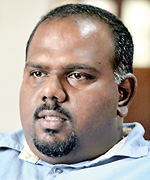
Chamila Karawita
“There are 87 movements and methods defeat an opponent and what our wrestlers know are just a handful. We are trying our level best to get the help of foreign experts. Some of our wrestlers were able to learn a bit more about sumo during the concluded World Championship and having it in Japan was an advantage to us,” de Zoysa went on to say.
Chamila Karawita, formerly a cricketer at school and club level, now a well known sports journalist for a national Sinhala daily newspaper, made his debut as a wrestler internationally alongside four others. The only wrestler to have represented Sri Lanka at international events was Lasantha Gunawardena, the team’s hope. Eventually Gunawardena finished as seventh overall in the lightweight class in the world among nearly 50 participants. Karawita became eighth among 54 in the middleweight class while Dinesh Jayasinghe was placed ninth in the heavyweight class.
“There were we four in the Men’s Open — Dinesh (Jayasinghe) in heavyweights, one in middleweight and Lasantha (Gunawardana) in lightweight. Wasantha Gunawardana joined us for the team event. Over 80 countries took part at this event and another achievement was Dulakshi Kulanayake, who competed in the Women’s Junior class and finishing among the world top 20,” Karawita briefed about his team’s performances.
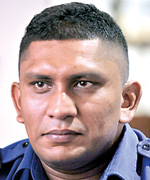
Lasantha
“What we observed at the championship was that we lacked preparation due to unavailability of correct technical guidance. Athletes from other countries were far ahead of us. With the natural physical ability we have as Sri Lankans, we can do better in time to come. There were many others from other countries who were below par to our standard. We know that can do more and better.”
“We saw how people took sumo. They were keen followers of this sport. We really need to take this sport into masses here in our country. Athletes from other countries were willingly supporting us; they saw our potential as amateurs and it’s our duty to impart what we learnt at the world championship in Japan to our local colleagues, when we meet each other next month for the National Championship,” he stressed while commending the administrators who make every effort to spread the sport in Sri Lanka.
“It’s wonderful to see a person like Kithsiri de Zoysa, working tirelessly to see sumo reach more athletes. What we fathomed after the championship was that we should not be aiming at gold medals, but we do have the ability to do better and reach higher standards. We need support in terms of coaching and funds. We should regroup in a week or so and practice hard to make the national squad a stronger one,” Karawita added.
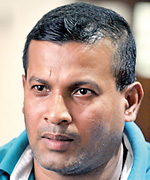
Wasantha - Pix by Amila Gamage
As in any other sport, sumo too is trying to fend off the usual woe – to come out better financially. So far they have failed to reach the top corporate, as sumo is still an unheard of sport in Sri Lanka. De Zoysa, who is also the President of Sri Lanka Judo Association, makes use of his personal funds, his contacts and the influence he could use, to help the gradually growing number of wrestlers in sumo feel confident, that they have stepped into the correct rung.
For the moment he has been able to attract the judokas and traditional wrestlers into sumo, a competitive full-contact wrestling sport where a rikishi (wrestler) attempts to force another wrestler out of a circular ring called dohyô or into touching the ground with anything other than the soles of the feet. Two such rikishis are Lasantha and Wasantha, who are productive traditional wrestlers.
“I come from a wrestling background, so it gave me an advantage to perform better as a sumo wrestler. I thought we did better which was expected at the world championship. I have a bronze medal in wrestling at Asian level and I have participated at many international events. What we sensed here was that we can aim for a medal in the forthcoming Asian and the World Championship,” said Lasantha while his teammate Wasantha too had the similar view to come out with.
“We had hopes of at least to finish at the top level but we could not reach that. At the same time there were many points we were able to learn. The exposure we got was really a much expected requirement. We as Sri Lankans are a naturally fit lot. Besides participating there were many learning points as an up and coming nation in sumo. We learned things like, technical perfection, perfect physical preparation and how to organise a tournament. We were able to build up good relationship with other athletes from all over the world. I’m sure we could develop to become a competitive nation in the sumo world”.
The Sri Lankan contingent included six wrestlers and three officials. They were Lasantha Gunawardena, Chamila Karawita, Dinesh Jayasinghe, Wasantha Gunawardana, Dulakshi Kulanayake and Gnanapali Gunawardana. The officials were Kithsiri de Zoysa, Merenchige Weeraratne and Piyal Dias.


